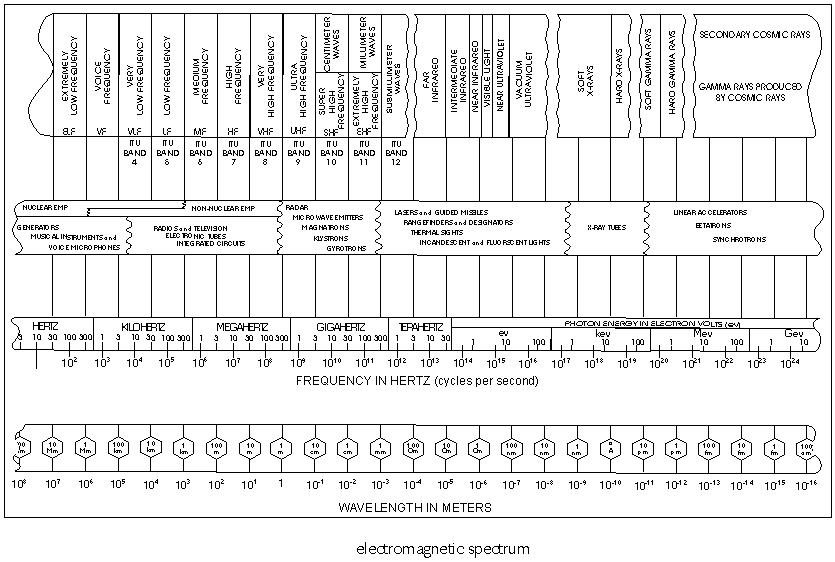2.2. Electromagnetic Spectrum¶
The electromagnetic spectrum is the range of frequencies (the spectrum) of electromagnetic radiation and their respective wavelengths and photon energies [64].
2.2.1. Radio Spectrum¶
International Telecommunication Union (ITU) divides the radio spectrum into 12 bands, each beginning at a wavelength which is a power of ten (10:sup:n) metres, with corresponding frequency of 3×10:sup:8−n hertz, and each covering a decade of frequency or wavelength [68].
| Band name | Abbreviation | Frequency | Wavelength | Example Uses |
|---|---|---|---|---|
| Extremely low frequency | ELF | 3–30 Hz | 100,000–10,000 km | Communication with submarines |
| Super low frequency | SLF | 30–300 Hz | 10,000–1,000 km | Communication with submarines |
| Ultra low frequency | ULF | 300–3,000 Hz | 1,000–100 km | Submarine communication, communication within mines |
| Very low frequency | VLF | 3–30 kHz | 100–10 km | Navigation, time signals, submarine communication, wireless heart rate monitors, geophysics |
| Low frequency | LF | 30–300 kHz | 10–1 km | Navigation, time signals, AM longwave broadcasting (Europe and parts of Asia), RFID, amateur radio |
| Medium frequency | MF | 300–3,000 kHz | 1,000–100 m | AM (medium-wave) broadcasts, amateur radio, avalanche beacons |
| High frequency | HF | 3–30 MHz | 100–10 m | Shortwave broadcasts, citizens band radio, amateur radio and over-the-horizon aviation communications, RFID, over-the-horizon radar, automatic link establishment (ALE) / near-vertical incidence skywave(NVIS) radio communications, marine and mobile radio telephony |
| Very high frequency | VHF | 30–300 MHz | 10–1 m | FM, television broadcasts, line-of-sight ground-to-aircraft and aircraft-to-aircraft communications, land mobile and maritime mobile communications, amateur radio, weather radio |
| Ultra high frequency | UHF | 300–3,000 MHz | 1–0.1 m | Television broadcasts, microwave oven, microwavedevices/communications, radio astronomy, mobile phones, wireless LAN, Bluetooth, ZigBee, GPS and two-way radios such as land mobile, FRS and GMRSradios, amateur radio, satellite radio, Remote control Systems, ADSB |
| Super high frequency | SHF | 3–30 GHz | 100–10 mm | Radio astronomy, microwave devices/communications, wireless LAN, DSRC, most modern radars, communications satellites, cable and satellite television broadcasting, DBS, amateur radio, satellite radio |
| Extremely high frequency | EHF | 30–300 GHz | 10–1 mm | Radio astronomy, high-frequency microwave radio relay, microwave remote sensing, amateur radio, directed-energy weapon, millimeter wave scanner, wireless LAN (802.11ad) |
| Terahertz or Tremendously high frequency | THz or THF | 300–3,000 GHz | 1–0.1 mm | Experimental medical imaging to replace X-rays, ultrafast molecular dynamics, condensed-matter physics, terahertz time-domain spectroscopy, terahertz computing/communications, remote sensing |
